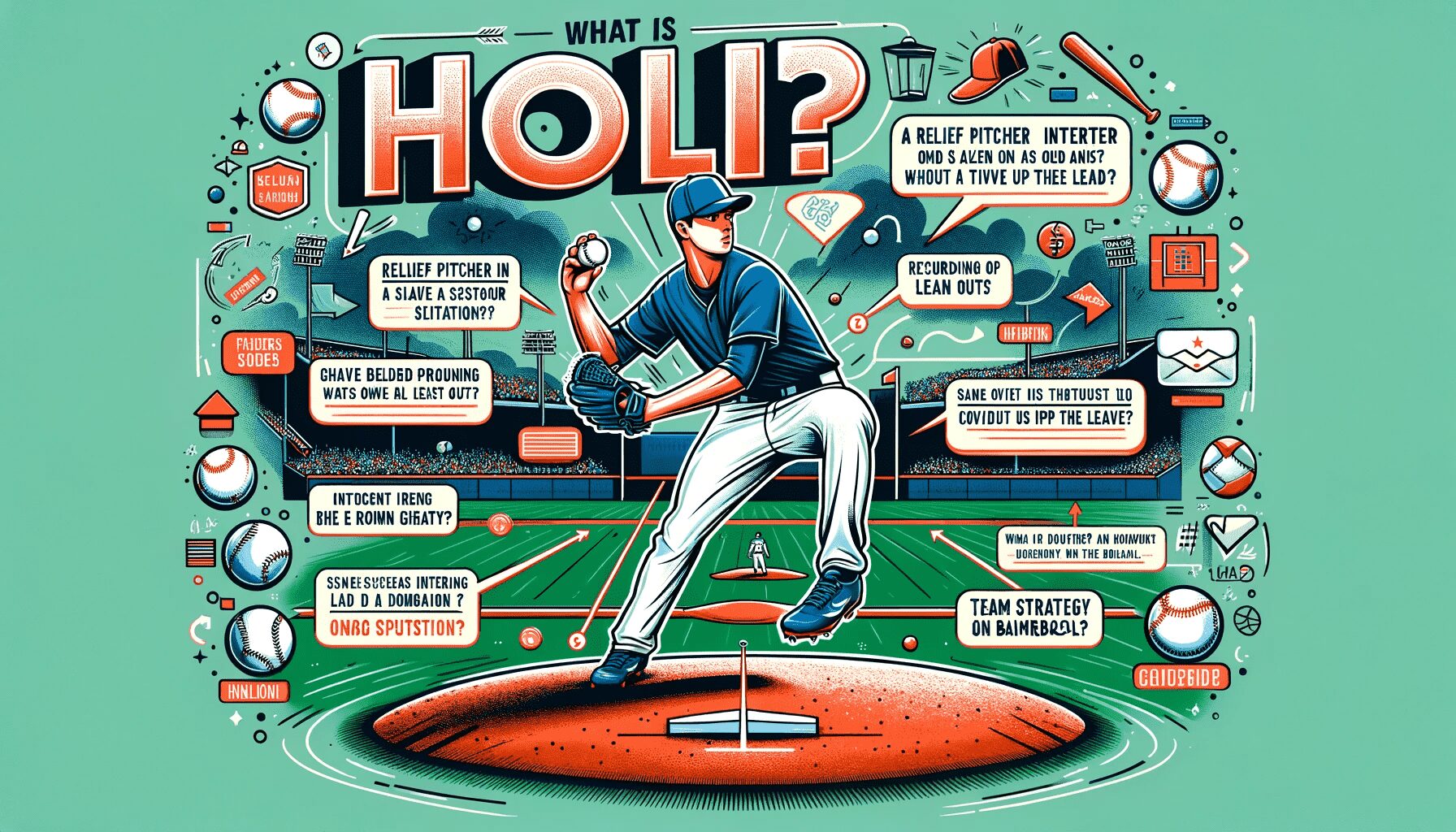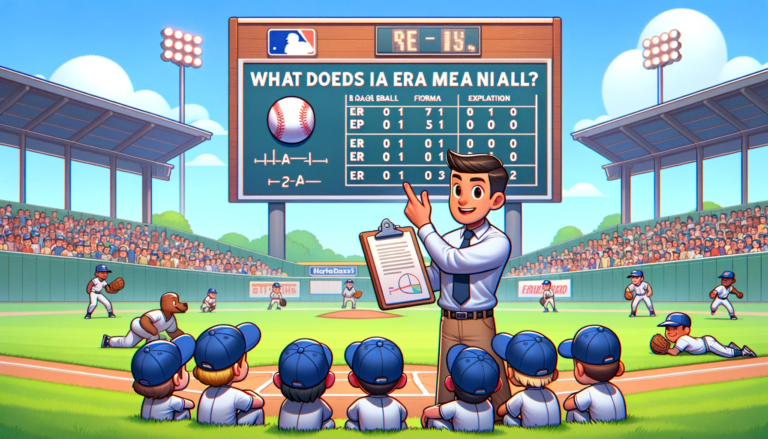What is a Hold in Baseball?
A hold in baseball is a statistic credited to a relief pitcher who enters the game in a save situation, successfully maintains the lead, but does not finish the game.
This stat helps recognize the efforts of middle relievers who play a crucial role in a team’s victory by maintaining the lead.
Let’s explore this concept to understand how it impacts the game and why it matters.
Key Takeaways
- A hold is a statistic in baseball that credits relief pitchers for maintaining a lead when they enter the game in a save situation.
- The hold metric is critical for evaluating middle relievers, who play a pivotal role in transitioning the game from starting pitchers to closers.
- Unlike saves, holds are not an official MLB statistic and can lead to debates regarding their value and impact on pitcher management and contracts.
- The history of the hold reflects the evolution of baseball strategy, particularly in managing the middle innings of a game.
- Future changes to baseball rules and the growing influence of analytics may alter how holds are perceived and utilized in the sport.
Understanding the Role of a Hold in Baseball

Defining a Hold: The Basics
In the realm of baseball, a hold is a statistic awarded to a relief pitcher who meets certain criteria during a game.
The concept of a hold is relatively straightforward, yet it is crucial to understanding the dynamics of relief pitching.
To be credited with a hold, a pitcher must:
- Enter the game in a save situation; that is, when the tying or go-ahead run is on base, at bat, or on deck.
- Record at least one out without surrendering the lead.
- Not finish the game or be credited with a save.
This metric recognizes the effectiveness of middle relievers. These pitchers are crucial in maintaining a team’s lead during the middle innings. They set the stage for the closer to come in and secure a save.
While holds are not as celebrated as saves, they are vital to a team’s bullpen strategy. They also reflect a pitcher’s ability to perform under pressure.
The Significance of Holds in Game Strategy
In the strategic landscape of baseball, holds play a pivotal role in shaping the middle innings of a game.
They serve as a bridge between the starting pitcher and the closer, ensuring that a team maintains its lead during these crucial stages.
The significance of holds extends beyond mere statistics; they influence the overall strategy of a game in several ways:
- Preserving the lead: A hold is awarded when a relief pitcher enters the game in a save situation, maintains the lead, and leaves without surrendering it.
- Tactical flexibility: Managers can deploy specialized middle relievers to face specific batters, exploiting matchups and strategic advantages.
- Bullpen management: Understanding when to pursue a hold can dictate bullpen usage, ensuring that key relievers are available for high-leverage situations later in the game.
The concept of holds also intersects with the broader strategy of team management. In fantasy baseball, for example, the inclusion of holds as a category changes the strategy of the draft, adding a layer of skill to the selection of relief pitchers.
This nuanced approach to bullpen management reflects the evolving nature of baseball strategy, where every decision can have a ripple effect on the outcome of a game and, ultimately, a season.
How a Hold Differs from Saves and Wins
While saves and wins are well-known baseball stats, a hold is a more nuanced measure. It recognizes the efforts of middle relievers.
A save is awarded to a pitcher who finishes a game for a winning team under certain conditions.
A hold, on the other hand, is given to a reliever who enters a save situation but does not finish the game.
The key difference lies in responsibility for the game’s outcome. A save goes to a pitcher who secures the final outs, keeping the team’s lead until the end.
A hold acknowledges a pitcher’s role in maintaining that lead during the middle innings.
- A win is attributed to the starting pitcher if the team is leading when the starting pitcher exits the game, and the lead is not relinquished.
- A save requires the reliever to finish the game without surrendering the lead, often in the last inning or two.
- A hold, on the other hand, does not have the finality of a save or the broad attribution of a win; it is a recognition of a reliever’s effectiveness in a high-pressure situation without the requirement of being the game’s concluding pitcher.
Read Also: What is the Mercy Rule in Baseball
The Mechanics of Achieving a Hold

Criteria for a Pitcher to Earn a Hold
In baseball, a hold is a statistic awarded to a relief pitcher who meets certain criteria during a game.
To earn a hold, a pitcher must enter the game in a save situation, which involves three key conditions:
- The pitcher enters the game with his team leading, but he is not eligible to be the winning pitcher.
- He maintains the lead for his team while facing at least one batter.
- He leaves the game without his team having relinquished the lead, and the lead is not lost before the game is won.
It’s important to note that a pitcher cannot earn a hold if he finishes the game or if he is credited with a save.
The role of the relief pitcher in securing holds is crucial, as they often bridge the gap between the starting pitcher and the closer, maintaining the team’s lead through the middle innings.
The Role of Middle Relievers in Securing Holds
Middle relievers are the unsung heroes in securing holds in baseball. These pitchers usually come into the game during the middle innings.
They often enter in high-pressure situations. This can be when the starting pitcher has left runners on base or when the game is closely contested.
- Their primary objective is to maintain the lead for the team, bridging the gap between the starter and the closer.
- A successful middle reliever will navigate through the opposing team’s lineup, often facing the heart of the order, and exit the game without surrendering the lead.
- The effectiveness of these pitchers is crucial, as they set the stage for a potential save situation, which can ultimately lead to a win.
The evolving role of bullpens and the increasing reliance on relievers with high-velocity pitches have made middle relievers more important than ever.
Teams now have an army of 95+ mph relievers ready to take the ball, making the task of earning holds both more challenging and more critical to a team’s success.
Common Situations Leading to a Hold
In baseball, a hold is a statistic credited to relief pitchers who enter the game in a save situation and maintain their team’s lead while facing at least one batter.
Some common situations that may lead to a hold include:
- A relief pitcher comes into the game with a small lead and successfully pitches through a high-pressure inning without surrendering the lead.
- The pitcher enters the game with runners on base and manages to prevent them from scoring, preserving the team’s advantage.
- A strategic pitching change is made in the later innings to exploit specific batter-pitcher matchups, and the reliever holds the lead.
Understanding these scenarios is crucial for grasping the strategic use of relief pitchers and the importance of holds in a game’s outcome.
MLB.com‘s glossary defines a hold this way: A hold occurs when a relief pitcher enters the game in a save situation and maintains his team’s lead for the next reliever or until the game’s conclusion.
Read Also: What is OPS in Baseball
The Controversy Surrounding Holds

Debates on the Value of the Hold Statistic
The hold has become a point of contention among baseball analysts and fans alike. Its supporters argue that it provides a valuable measure of a relief pitcher’s effectiveness in high-pressure situations.
Critics, however, question its significance, pointing out that the hold’s criteria can sometimes reward mediocre pitching performances.
- The hold is seen as a way to quantify a reliever’s contribution to preserving a lead.
- Detractors believe it can be misleading, as it does not account for the quality of the outs a pitcher achieves.
- There is also a concern that the hold may encourage managers to make decisions based on statistics rather than game context.
The debate extends to the impact of holds on player recognition and compensation. While some argue that holds can highlight the skills of middle relievers, others feel that the statistic may inflate the value of a player’s performance beyond what is warranted.
How Holds Influence Pitcher Usage and Management
The introduction of the hold statistic has significantly altered the landscape of pitcher usage and management in baseball.
Pitchers are now often strategized around their ability to secure holds, leading to a more specialized bullpen where roles are clearly defined.
This has several implications:
- Middle relievers are utilized in high-leverage situations, typically in the 6th or 7th inning, to maintain a lead and bridge the gap to the closer.
- Managers are more inclined to pull starting pitchers earlier in the game, even if they are performing well, to deploy a reliever with a strong track record of holds.
- The hold statistic has contributed to a shift in how a pitcher’s effectiveness is measured, with less emphasis on wins and more on their ability to preserve leads.
This strategic emphasis on holds has also impacted how teams construct their rosters, often carrying more pitchers who specialize in short, high-pressure appearances.
As a result, the traditional role of the starting pitcher is evolving, with fewer complete games and an increased reliance on the bullpen.
The Impact of Holds on Player Contracts and Salaries
The hold statistic, while not as prominent as wins or saves, has begun to influence the financial aspects of baseball, particularly in the realm of player contracts and salaries.
Teams are increasingly recognizing the value of middle relievers who can secure holds, leading to a reevaluation of their worth during contract negotiations.
- Middle relievers who consistently earn holds may see their market value increase, as their contributions to preserving leads are quantified.
- Contract incentives may be structured around the accumulation of holds, providing additional earnings for setup men.
- The arbitration process for salary determination also takes into account a pitcher’s hold totals, potentially leading to higher salaries for those with significant hold numbers.
However, the hold statistic’s impact on salaries is still a subject of debate, with some arguing that it does not fully capture a pitcher’s effectiveness or contribution to the team’s success.
As the metric continues to evolve, its role in shaping the financial landscape of baseball will be closely watched by players, agents, and management alike.
Read Also: What is the Pennant in Baseball
Historical Perspective on Holds in Baseball

Evolution of the Hold Statistic Over Time
The hold statistic in baseball has undergone significant changes since its inception. Initially, holds were not officially tracked, and their importance was often overshadowed by more traditional statistics like wins and saves.
However, as the game evolved and the role of relief pitchers became more specialized, the hold began to gain recognition for its strategic value in preserving leads before the closer took the mound.
Over time, the adoption of advanced analytics has further shaped the perception and utilization of the hold.
With tools like Statcast, teams can now analyze the effectiveness of relief pitchers in high-leverage situations, leading to a more nuanced understanding of a pitcher’s contribution beyond traditional stats.
This has resulted in a greater appreciation for middle relievers and the holds they accumulate.
The trajectory of the hold statistic reflects broader trends in baseball analytics, where every play and player contribution is meticulously scrutinized.
As baseball teams increasingly rely on data to make decisions, the hold remains an important measure for assessing how well relief pitchers perform. You may read the guide on What is an Assist in Baseball
Notable Pitchers and Memorable Holds in Baseball History
Throughout baseball history, certain pitchers have distinguished themselves not just for their wins or saves, but for their ability to secure holds, a statistic that often goes unnoticed.
Bryan Abreu of the Houston Astros stands out as a prime example, with a remarkable 1.75 ERA and a 39.8% Whiff rate, showcasing the impact a dominant middle reliever can have on the game.
The Hall of Fame includes many pitchers who, during their careers, may not have been recognized for holds but certainly set the stage for the importance of middle-inning pitching.
Pitchers like Cy Young, with his unparalleled records, and Roy Halladay, known for his no-hitter in the 2010 NL playoffs, exemplify the evolving role of pitchers over time.
While not all Hall of Famers would have tallied holds under today’s rules, their contributions paved the way for the modern bullpen specialist.
Memorable moments in baseball often hinge on the performance of these middle relievers. Their holds may not be as celebrated as a perfect game or a no-hitter, but they are crucial in maintaining leads and setting the stage for closers.
The significance of a hold may be debated, but the pitchers who consistently deliver them are invaluable to their teams.
Comparing Past and Present Strategies for Middle Innings
In the past, baseball strategies heavily relied on pitching and speed on the basepaths, with tactics like the Baltimore chop aiming to secure infield singles.
The game has evolved, with starting pitchers now often expected to cover only 6-7 innings before handing the reins to the bullpen. This shift has underscored the importance of middle relievers and the holds they secure.
Today’s game sees a greater emphasis on bullpen specialization and the strategic deployment of pitchers for specific situations.
The role of middle relievers has become more pronounced, with their ability to earn holds being a critical bridge to the game’s later stages.
Comparing strategies across eras:
- Past: Complete games by starters were the norm, with less reliance on the bullpen.
- Present: Relievers are used more strategically, often in one-inning stints, to maintain leads and set up closers.
The evolution of these strategies reflects the changing dynamics of the game, where the hold has become a valuable tool for managers to measure the effectiveness of their middle-inning tactics.
Read Also: What is Lob in Baseball
Conclusion
In baseball, a hold is a stat that gives credit to middle relievers. These pitchers come into the game before the closer and help maintain the team’s lead without finishing the game. While not as famous as saves, holds are important.
They show a reliever’s ability to handle tough situations and keep the lead. This helps their team stay in a good position to win as the game goes on.
Frequently Asked Questions
What exactly is a hold in baseball?
A hold is a statistic awarded to a relief pitcher who enters the game in a save situation, maintains his team’s lead while on the mound, and leaves the game without finishing it, all without surrendering the lead.
How does a hold differ from a save in baseball?
A hold is similar to a save but is recorded by a relief pitcher who does not finish the game. A save is awarded to a pitcher who finishes a game for the winning team. This usually happens under specific circumstances, often preserving the lead.
Can a pitcher earn both a win and a hold in the same game?
No, a pitcher cannot earn both a win and a hold in the same game. A win is given to the pitcher responsible for the team taking the lead. A hold is for a reliever who helps maintain that lead without finishing the game.
Why is there controversy surrounding the hold statistic in baseball?
The controversy comes from the idea that holds can inflate a reliever’s value. This might not truly reflect their effectiveness or their contribution to the team’s success. This perception can influence player contracts and management decisions.
How has the hold statistic evolved over time in baseball?
The hold statistic has evolved as the role of relief pitchers has become more specialized. It was not officially recognized until the 1980s, reflecting the increased importance of middle relievers in preserving leads before the closer enters.
What impact do holds have on pitcher contracts and salaries?
Holds can impact contracts and salaries. They provide a measurable statistic for middle relievers. These pitchers may not get many saves or wins but are crucial in a team’s bullpen strategy.







